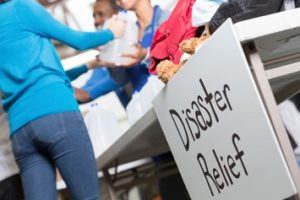As part of their corporate social responsibility (CSR) programs, many employers encourage and enable workers to participate in volunteer opportunities in disaster-stricken areas. But before you sign off on letting a work crew head for Houston or Puerto Rico or the U.S. Virgin Islands, make sure that you are not putting your workers’ health and safety at risk.
Here are some tips for assuring the safety of your employees who are volunteering to help individuals affected by disasters.
Stay Home
Wait—don’t people need help with cleanup? Tearing out moldy drywall and cutting up large trees—that sort of thing? So, how does staying home help?
In the immediate wake of a disaster, local authorities may be asking everyone to stay off the roads, so if you go rushing in to help, you could not only be putting your own workers unnecessarily at risk, but also contributing to problems in the disaster area. In Houston, for example, authorities dealing with the likelihood of even more flooding asked people to stay away, at least until the floodwaters had started to recede.
The other thing to consider is whether you could be more use where you are. In the wake of many natural disasters, a call goes out for help that is located out of the immediate area. Your employees may be able to provide foster homes for displaced shelter animals or temporary housing for displaced families; your workplace may be able to provide temporary office space for displaced businesses. Check with shelter organizations, your professional and corporate groups, and services like AirBnB that offer some measure of security to both hosts and guests. Or, consider hosting a blood drive. Anytime there is a widespread power outage, blood banks are at risk of losing their inventory—local blood donation groups may be coordinating with groups in the disaster area. Assistance you can provide from within your local area is vital, and that may be safer than sending workers to the disaster zone.
Plan Ahead
Ordinarily, when workers travel to a developed area, they can count on things like hotels, restaurants, and drugstores being available at their destination. When they’re traveling to a disaster-stricken area, that may not be the case. Available hotels may be filled with displaced residents; restaurants and other businesses may be operating with limited schedules and resources, if at all. Before your workers leave for an area with disrupted infrastructure, make sure that they will have what they need when they get there.
Check with the State Department
One of the responsibilities of the U.S. Department of State is to safeguard Americans traveling abroad—whether for business, pleasure, or humanitarian reasons. So, if your employees will be traveling out of the country, check the resources at travel.state.gov, including their “Best Practices for Volunteering Abroad” topic page, which includes useful tips like:
- Make sure that there are no travel advisories for the region to which your workers are traveling.
- Make sure that workers have all recommended vaccinations before departure. Some vaccination series take several weeks to complete, so start this process early.
- Check your overseas medical insurance coverage, and purchase supplemental insurance if needed.
- Provide an orientation for volunteers on country-specific and task-specific information and safety concerns.
- Enroll all volunteers in the Department of State’s Smart Traveler Enrollment Program, to help ensure the U.S. embassy in your destination country can help you in case of an emergency.

